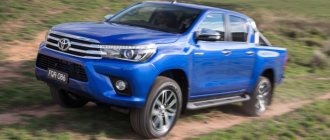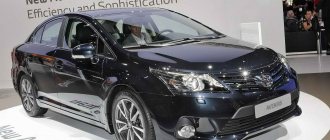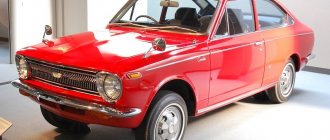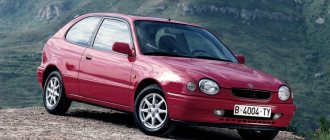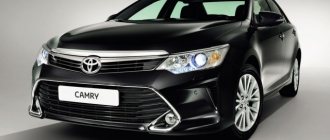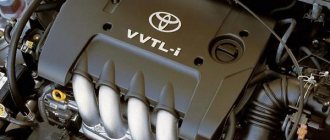All generations of Toyota HiLux
2021 – today
IX
2019 – 2020
VIII restyling
2016 – 2018
VIII
2005 – 2016
VII
Fast passage
- A Acura
- Alfa Romeo
- Alpina
- Alpine
- Aston Martin
- Audi
- Aurus
- B Bajaj
- Bentley
- BMW
- Brilliance
- Bugatti
- BYD
- C Cadillac
- Caterham
- Changan
- Chery
- CheryExeed
- Chevrolet
- Chrysler
- Citroen
- Daewoo
- Daihatsu
- Dartz Motors
- Datsun
- Detroit Electric
- DFM
- Dodge
- FFAW
- Ferrari
- Fiat
- Ford
- Foton
- G GAC
- GAZ
- Geely
- Genesis
- GMC
- Great Wall
- GTA Motor
- H Hafei
- Haima
- Haval
- Hawtai
- Hennessey
- Honda
- Hummer
- Hyundai
- I Icon
- Infiniti
- Iran Khodro
- Isuzu
- JJAC
- Jaguar
- Jeep
- K KIA
- Koenigsegg
- L Lada
- Lamborghini
- Land Rover
- Lexus
- LIFAN
- Lincoln
- Lotus
- Luxgen
- M Marussia
- Maserati
- Maybach
- Mazda
- Mazzanti
- McLaren
- Mercedes-Benz
- MG Cars
- MINI
- Mitsubishi
- N Nissan
- Opel
- P Pagani
- Peugeot
- PGO
- Porsche
- Proton
- Q Qoros
- Ravon
- Renault
- Rolls-Royce
- S Saab
- Samsung
- SEAT
- SeAZ
- Skoda
- Smart
- SsangYong
- Subaru
- Suzuki
Go
The Toyota Hilux pickup truck debuted in the Japanese market in 1967. For European car enthusiasts, this model became available only in 2005. According to the manufacturer, since the late 1970s, global sales of the pickup truck have exceeded 12 million units. The popularity of the machine is largely due to its reliability and durability. The current sixth generation of Hilux differs from its predecessors, first of all, in its increased level of comfort. In addition, the car began to look much more solid in appearance. Significant changes also affected the design of the car - the manufacturer strengthened the frame almost 1.5 times, re-developed the suspension and made the engines more economical. The Toyota Hilux model is based on the IMV platform, which is a classic spar frame with energy-absorbing zones, a rigid rear axle and semi-elliptic springs. On a similar basis, factories in Argentina, Indonesia, Thailand and South Africa produce minivans and SUVs that are sold in 140 countries. The car interior is designed for five people. Initially, the car was equipped with only a 102-horsepower diesel engine, but later the line of power units was replenished with a 171-horsepower turbodiesel.
Body and interior
The car was equipped with a body consisting of a 4-door passenger capsule and a cargo platform with metal sides. The split design reduced the level of deformation when driving a loaded pickup truck on uneven roads. There were plastic covers around the wheel arches to protect against damage from branches or stones. The front bumper with a slot for the central air intake was equipped with windows for installing fog lights. The radiator grille had a chrome frame and horizontal crossbars made of dark plastic.
The body consists of a 4-door passenger capsule.
There was a flat engine air intake on the hood of the car. The side glazing was covered with an athermal protective layer by default. There were turn signal indicators in the rear view mirror housings. The cargo compartment had brackets for rigging, which made it possible to keep cargo from inadvertently shifting during transportation. The tailgate was equipped with a lock. On expensive versions, there was a hole for the rear view camera lens.
Inside, hard plastic was used, which could withstand mechanical stress and was easily washed off from dirt. In front of the driver was an instrument cluster with 3 deep wells. Between the central air ducts there was a radio tape recorder, on top of which there was an information board. The wide center console provided niches for small items. The interior design was consistent with the commercial purpose of the pickup truck.
The chairs had shallow lateral support bolsters; wear-resistant fabric or artificial leather was used for finishing.
Technical characteristics of Toyota HiLux generation VII
pickup truck 4-door
SUV
- width 1,760mm
- length 5 260mm
- height 1,860mm
- ground clearance 212mm
- seats 5
| Engine | Name | Fuel | Drive unit | Consumption | Up to a hundred | Max. speed |
| 2.5 MT (144 hp) | Standard | DT | Full | 7,2 / 10,1 | 13.3 s | 170 km/h |
| 2.5 MT (144 hp) | Comfort | DT | Full | 7,2 / 10,1 | 13.3 s | 170 km/h |
| 2.5 MT (144 hp) | Elegance | DT | Full | 7,2 / 10,1 | 13.3 s | 170 km/h |
| 3.0 AT (171 hp) | Prestige | DT | Full | 7,3 / 11,7 | 12 s | 175 km/h |
| 3.0 AT (171 hp) | Prestige Plus | DT | Full | 7,3 / 11,7 | 12 s | 175 km/h |
Looking for Toyota HiLux reviews? View reviews of Toyota HiLux
Updated Toyota Hilux 7 pickup
The 7th generation Toyota Hilux pickup truck in the N70 body appeared in 2005. It is built on the modernized platform of its predecessor Hilux N60, but is noticeably larger in size, moving into the mid-size class.
For different markets, the Toyota Hilux is produced under different names and has several versions: with a single cab (Regular Cab), one-and-a-half (Extended Cab) and double cab (Crew Cab). Only the last version with four full doors and a five-seater cabin is presented on the Russian market. The length of such a pickup truck is 5,260 mm, width - 1,835, height - 1,850, ground clearance (clearance) - 212 mm.
Options and prices Toyota Hilux 2015
Loan for this car
Calculate
| Equipment | Price | Engine | Box | Drive unit |
| 2.5D Standard MT | 1 672 000 | diesel 2.5 (144 hp) | mechanics (5) | full |
| 2.5D Comfort MT | 1 778 000 | diesel 2.5 (144 hp) | mechanics (5) | full |
| 2.5D Elegance MT | 1 797 000 | diesel 2.5 (144 hp) | mechanics (5) | full |
| 3.0D Prestige AT | 1 987 000 | diesel 3.0 (171 hp) | automatic (5) | full |
| 3.0D Prestige+ AT | 2 053 000 | diesel 3.0 (171 hp) | automatic (5) | full |
- Toyota catalog
- Owner reviews
The Toyota Hilux pick-up loading platform measures 1,545 x 1,515 x 450 mm and the all-wheel drive workhorse has a maximum load capacity of 805 kg. To increase the height of the body and the safety of transported goods, a kung car is often installed on a Hilux.
New 8th generation Toyota Hilux pickup
In the summer of 2011, the Japanese automaker introduced an updated version of the Toyota Hilux pickup truck for the 2012 model year, sales of which began in the fall of the same year. Among the external differences of the restyled version of the model are a new radiator grille, a modified front bumper and hood, different front and rear fenders, as well as retouched head optics.
Inside, the updated Toyota Hilux pickup truck received improved finishing materials, a modified instrument panel, a multimedia system with a 6.1-inch color display and a new steering wheel with silver inserts.
The car is supplied to the European market, including Russia, with a 2.5-liter diesel engine with a capacity of 144 hp. (343 Nm) and a 3.0-liter diesel engine producing 170 hp. (360 nm). The first is paired with a 5-speed manual transmission, while the more powerful version is available exclusively with a five-speed automatic transmission.
You can buy a new Toyota Hilux 2015 pickup truck at a price starting from 1,672,000 rubles, and the most expensive modification is estimated at 2,053,000 rubles. The latter's equipment includes six airbags, ABS, ESP, fog lights, a light sensor, full power accessories, climate control, heated seats, an audio system with MP3, a rear view camera, leather interior and alloy wheels. Additional payment for metallic painting - 14,000 rubles.
Photo Toyota Hilux 2014 Toyota Hilux pickup photo Toyota Hilux interior photo Photo Toyota Hilux pick-up VII Car Toyota Hilux 7 Toyota Hilux 2014 photo
Competitors
Ford RangerFoton TunlandGreat Wall DeerGreat Wall Wingle 3Isuzu D-MaxMitsubishi L200Nissan NavaraNissan NP300Peugeot Pick UpSsangYong Actyon SportsToyota HiluxVolkswagen AmarokUAZ Pickup
Toyota Hilux VII video
Show more https://www.youtube.com/watch?v=dIgkaKH5lXY
Options and cost
Several trim levels were available for Russian buyers:
- “Standard”, equipped with a folding tailgate. The interior featured fabric-trimmed seats and a steering wheel with a polyurethane rim. Basic equipment included air conditioning, heated driver and front passenger seats, an additional interior heater and power windows for all doors. By default, front airbags and central locking with control buttons in the key head were installed. The price started from 1.672 million rubles.
- “Comfort”, equipped with alloy wheels, wheel arch extensions and tires measuring 255/70 R17. The front bumper was painted in body color, and the fog lights worked. There was a rear view camera, a leather steering wheel with control buttons and a radio with a 6.1″ display. The price was 1.778 million rubles.
- "Elegance", equipped with side steps, leather interior trim and automatic climate control. The front seats featured backrests with increased lateral support and integrated airbags. Pickup trucks were also equipped with curtains to protect the heads of the driver and passengers. The modification price for 2014 was 1.797 million rubles.
- “Prestige”, equipped with 265/65 R17 tires and a fabric interior. The car was offered only with an automatic transmission and had an expanded set of safety systems corresponding to the Elegance version. Dealers offered cars at prices starting from 1.987 million rubles.
- “Prestige Plus”, equipped with a leather interior, cruise control and power windows with protection against injuries. The modification price on the Russian market was 2.053 million rubles.
Owner reviews
Roman, 44 years old, Novosibirsk
In the summer of 2014, I purchased a Toyota Hilux pickup truck with a 2.5-liter diesel engine and a manual transmission from a dealer. Additionally, I installed metal sheets to protect the engine, gearbox and fuel tank. I had to buy and install a plastic liner in the cargo compartment, but I refused the protective curtain. Average consumption is 11 liters per “hundred”; the use of air conditioning does not affect efficiency and dynamics. I drove several times over distances of more than 1000 km, and there was no feeling of discomfort from being behind the wheel for a long time.
Timofey, 38 years old, Murmansk
He worked as a hired driver for a Hilux equipped with a 3 liter engine and an automatic transmission. The plastic in the cabin is hard, and the trim parts squeaked at low temperatures and on rough roads. The heater's performance was not enough to heat the glass in winter; after installing the autonomous Webasto device, the problem disappeared. The paintwork on the hood and fenders is weak, chips appeared after the first drive on the highway. At the time of leaving the company, the vehicle's mileage exceeded 120 thousand km, and no major breakdowns occurred during operation.
